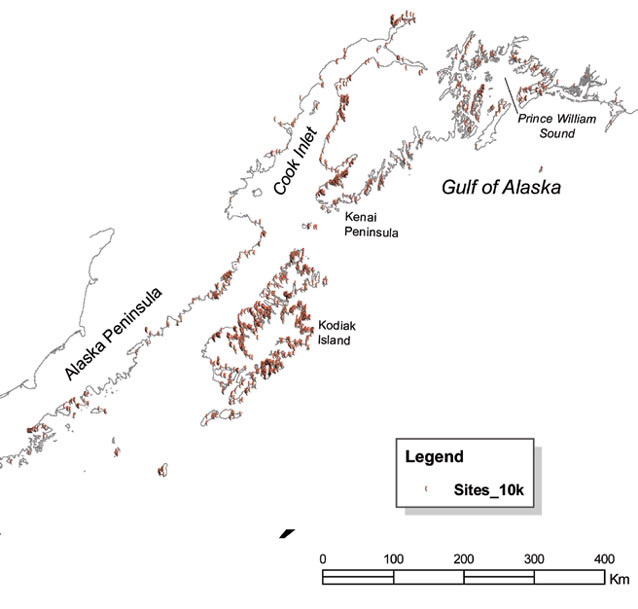
This paper summarizes preliminary results of a regional Geographic Information System (GIS) study of the spatial relationships between coastal archaeological sites and maritime subsistence resources in the central Gulf of Alaska.
Two modes of variability are relevant to the model – the uneven geographic distributions of key subsistence resources and temporal cycles in the climate and marine ecosystem (Crowell et al. 2003). The latter include the annual seasonal cycle, the 20 to 50 year intervals of the Pacific Decadal Oscillation (PDO), and multi-century trends including the Medieval Warm Period (~A.D. 1000-1400) and Little Ice Age (~A.D. 1400-1900). Salmon increase during warmer PDO phases, while colder phases yield increases in forage fish and shrimp that in turn support larger numbers of the seals, sea lions, and seabirds who consume these prey (Benson and Trites 2002, Finney et al. 2002, McGowan et al. 1998). We propose that indigenous hunting and fishing peoples of the Gulf of Alaska settled primarily in areas with the highest numbers and diversity of marine fish, mammal, and bird harvesting locales in order to increase harvesting efficiency and to buffer the risk of individual species declines due to climate and marine ecosystem change.
Data and Methods of Analysis
The study area spans 10,560 mi (17,000 km) of mainland and island shoreline including the Alaska Peninsula, Cook Inlet, the Kodiak Island archipelago, Kenai Peninsula, and Prince William Sound, a region that encompasses the traditional territories of the Sugpiaq (Alutiiq) and coastal Dena’ina. The sample includes 1,959 known coastal archaeological sites: 41% are estimated from radiocarbon dates, artifacts, and features to have been occupied since A.D. 900; 10% are older than A.D. 900; and 49% are of indeterminate age (Figure 1). For each of the 6,800 shoreline segments (1.6 mi/2.5 km in length) we computed the number of archaeological sites present as well as the number of locally accessible harvest locales for each of 24 different fish, bird, and sea mammal species (Figure 4).
Harvest locales for offshore subsistence species (e.g. seal concentrations, bird rookeries, and pelagic fishing areas) were counted as accessible if located within a 6.2 mi (10 km) kayak travel radius from any point on the shoreline segment. Access to anadromous fish streams was computed using a 0.6 mi (1 km) pedestrian radius, reflecting the ethnohistoric pattern of establishing fishing camps at these locations. Statistical analysis utilized simple “richness” scores – the total number of resource access locales (all species) for each segment – as well as multivariate correspondences between site occur-rence and the availability of various species groups.
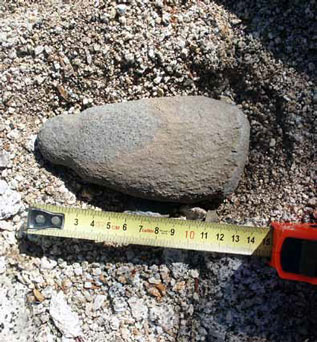
A. Crowell
Results
Geographically, the highest richness scores occur in protected bays with complex shorelines (including bay mouth islands), while richness diminishes toward the inner reaches of bays and along straight, exposed coastlines (Figure 4).
The pattern is multiscalar, applying to very large features (Cook Inlet and Prince William Sound) as well as more localized coastal involutions. The richest areas combine coastal complexity with proximity to the central Gulf of Alaska upwelling zone located at the mouth of Cook Inlet.
These areas include the northern Kodiak archipelago, Cape Elizabeth and Kachemak Bay at the tip of the Kenai Peninsula, and the Kukak Bay-Amalik Bay section of the Alaska Peninsula.
| GIS Layer | Data Source |
|---|---|
| Archaeological Sites | AK Office of History and Archaeology |
| King Salmon | Alaska Dept. of Fish and Game 2006 |
| Sockeye Salmon | Alaska Dept. of Fish and Game 2006 |
| Coho Salmon | Alaska Dept. of Fish and Game 2006 |
| Chum Salmon | Alaska Dept. of Fish and Game 2006 |
| Pink Salmon | Alaska Dept. of Fish and Game 2006 |
| Steelhead | Alaska Dept. of Fish and Game 2006 |
| Sea Bird Colonies | U.S. Fish and Wildlife Service 2006 |
| Harbor Seal Haulouts | National Marine Fisheries Service 2006 |
| Sea Lion Haulouts | National Marine Fisheries Service 2006 |
| Sea Lion Concentrations | National Ocean & Atmospheric Administration 2003 |
| Harbor Porpoise | National Ocean & Atmospheric Administration 2003 |
| White Whale | National Ocean & Atmospheric Administration 2003 |
| Minke Whale | National Ocean & Atmospheric Administration 2003 |
| Fin Whale | National Ocean & Atmospheric Administration 2003 |
| Dall's Porpoise | National Ocean & Atmospheric Administration 2003 |
| Herring | National Ocean & Atmospheric Administration 2003 |
| Pacific Code | National Ocean & Atmospheric Administration 2003 |
| Walley Pollock | National Ocean & Atmospheric Administration 2003 |
| Lingcod | National Ocean & Atmospheric Administration 2003 |
| Halibut | National Ocean & Atmospheric Administration 2003 |
| English Sole | National Ocean & Atmospheric Administration 2003 |
| Dover Sole | National Ocean & Atmospheric Administration 2003 |
| Arrowtooth Flounder | National Ocean & Atmospheric Administration 2003 |
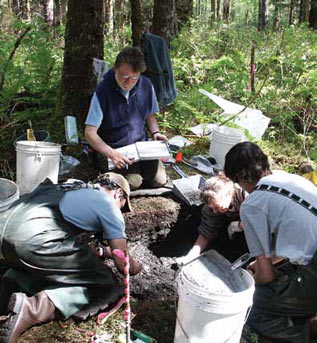
A. Crowell
A graph of site count per segment plotted against rich-ness score (Figure 6) suggests a threshold at approximately 10 resources, below which relatively few sites are present at most locations. Out of 856 coastal segments where sites were present, 776 (90.6%) had richness scores of 10 or greater (Figure 7), a relationship that is highly significant (p = <0.0001). The presence of other sites within 7.5 mi (12 km) also has a strong predictive value (p = <.001), reflect-ing the clustering of sites within resource-rich zones (Figure 8). As a further indication of this pattern, all 1,959 regional archaeological sites were contained within only 13% of shoreline segments, while the other 87% contained no settlements. Some neighboring sites are probably vil-lages and camps used by contemporary people during dif-ferent parts of the year, while others reflect shared settle-ment preferences by unrelated groups at different times.
We also undertook a factor analysis of the resource matrix to determine which resources or resource groups have dominant effects on site location. The analysis showed that the 24 resource variables could be reduced to six factors. Three of these – Factor 1 (sea lions, cod, halibut, herring), Factor 4 (anadromous fish including 3 species of salmon and steelhead trout), and Factor 6 (seals and seabird colonies) were found to have highly significant influences (p = <.0001) on site count. Each one unit increase in Factor 1 increased predicted site count by 33.7%; in Factor 4 by 28.7%; and in Factor 6 by 8.6%.
This result indicates the relatively equal but segregated influences of pelagic fish (along with sea lions, one of the major predators of such fish) and of salmon, reflected in Factors 1 and 4 respectively. In part, this segregation is likely to reflect seasonal rotation between fall-winter-spring villages and mid to late summer salmon camps. Factor 6 represents the association of seal haul-outs and bird colonies on offshore islands and the influence that these have on attracting human settlement to proximate coastlines.
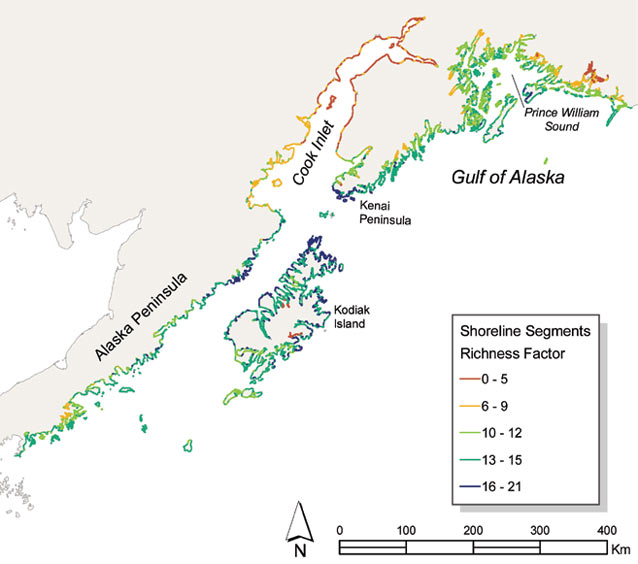
On a longer temporal scale, Factor 1 may represent subsistence emphasis and corresponding site location choices during colder phases when salmon are reduced but sea mammals and forage fish (e.g. herring) increase.
Factor 4 would represent the alternative warm phase strategy, when coastal residents moved to major salmon rivers and relied on mass production and storage of this resource for winter consumption. Intraregional mobility of this type is documented by archaeological and ethnohistorical instances including Sugpiaq settlement along the salmon-rich Karluk River on Kodiak Island during the Medieval Warm period and later resettlement along the sea mammal-rich coast of eastern Kodiak at the peak of the Little Ice Age in the late 1700s (Clark 1987).
Dena’ina groups expanded into Cook Inlet at the start of the Medieval Warm Period around A.D. 1000 and adopted an intensive salmon fishing orientation.
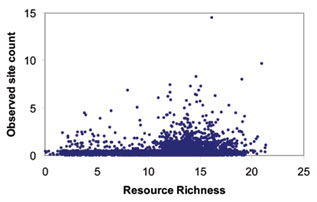
Discussion
Indigenous settlement along the central Gulf of Alaska coast, as represented by a sample of almost 2,000 archaeological sites, was strongly influenced by proximity to marine subsistence resources. We have shown that distributions of fish, mammal, and bird species can be used to compute summed richness scores for individual shoreline segments, and that these scores correlate highly with the frequency of known coastal sites. In geographic terms, areas of resource richness and high site density are associated with complexly indented shorelines, in particular the protected outer portions of bays and fiords. We suggest that the concentration and diversity of resource harvest locales in such areas supported extended occupation across all time scales from seasonal to millennial by mitigating climatic and ecosystem fluctuations in the abundance of individual food species.
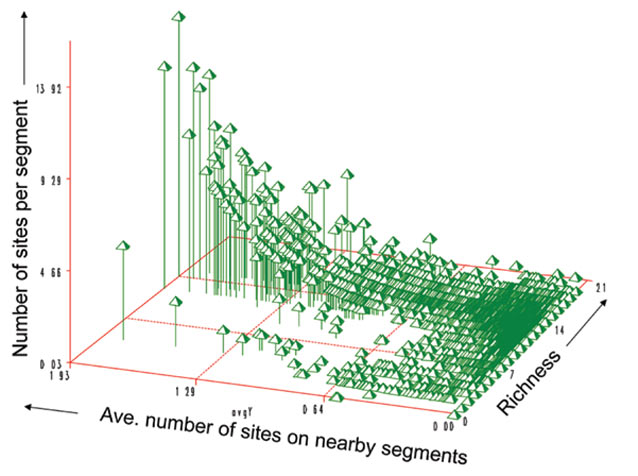
These regional findings extend and confirm our findings from a similar GIS study of resources and settlement patterns on the Gulf of Alaska coastline of Katmai National Park and Preserve (Crowell et al. 2003), as well as a previous regional study (Erlandson et al. 1992). This GIS predictive model has significant management implications for national parks bordering the Gulf of Alaska (Katmai, Lake Clark, Kenai Fjords, Wrangell-St. Elias, and Glacier Bay), where the most high priority regions for cultural resource documentation and protection are likely to be shorelines with associated high resource scores.
Acknowledgements
We acknowledge and appreciate a number of contributions to this collaborative project. The NPS Regional Office (Anchorage) and the Ocean Alaska Science and Learning Center (Seward) funded extensive archaeological site surveys by Aron L. Crowell and the Smithsonian Institution’s Arctic Studies Center in Katmai, Kenai Fjords, Wrangell-St. Elias, and Glacier Bay national parks. A Wenner-Gren Foundation research grant to the Arctic Studies Center enabled the GIS analysis by Mark Matson and statistical analysis by Joseph Liddle. The Office of History and Archaeology (Alaska Department of Natural Resources) provided locational and descriptive data for the archaeological site sample. The Alaska Department of Fish and Game, the National Marine Fisheries Service, the National Oceanic and Atmospheric Administration, and the U.S. Fish and Wildlife Service provided digital data for the GIS model.
References
Alaska Department of Fish and Game. 2006.
Alaska Waters Catalog of Anadromous Fish. (http://www.adfg.alaska.gov/index.cfm?adfg=maps.data)
Benson, Ashleen J., and Andrew W. Trites. 2002.
Ecological Effects of Regime Shifts in the Bering Sea and eastern North Pacific Ocean. Fish and Fisheries 3: 95-113.
Clark, Donald W. 1987.
On a Misty Day You Can See Back to 1805: Ethnohistory and Historical Archaeology on the Southeastern Side of Kodiak Island, Alaska. Anthropological Papers of the University of Alaska 21(1-2): 105-132.
Crowell, Aron L., Mark Matson, and Daniel H. Mann. 2003.
Implications of “Punctuated Productivity” for Coastal Settlement Patterns: A GIS Study of the Katmai Coast, Gulf of Alaska. Alaska Journal of Anthropology 1(2): 62-96.
Erlandson, Jon, Aron L. Crowell, Christopher Wooley, and James Haggarty. 1992.
Spatial and Temporal Patterns in Alutiiq Paleodemography. Arctic Anthropology 29(2): 42-62.
Finney, Bruce P., Irene Gregory-Eaves, Marianne S.V. Douglas, and John P. Smol. 2002.
Fisheries Productivity in the Northeastern Pacific Ocean Over the Past 2,200 Years. Nature 416:729-733.
McGowan, John A., Daniel R. Cayan, and Leroy M. Dorman. 1998.
Climate-Ocean Variability and Ecosystem Response in the Northeast Pacific. Science 281: 210-217.
National Marine Fisheries Service. 2006.
Harbor Seal Haul-out Locations and Stellar Sea Lion Sites. National Marine Mammal Laboratory, NOAA Alaska Fisheries Science Center, National Marine Fisheries Service.
National Oceanic and Atmospheric Administration. 2003.
West Coast of North America Living Marine Resources Data Atlas: Digital Version, 2003. (http://westcoastatlas.noaa.gov/download.html)
U.S. Fish and Wildlife Service. 2006.
The Beringian Seabird Colony Database. U.S. Fish and Wildlife Service, Migratory Bird Management.
Part of a series of articles titled Alaska Park Science - Volume 11 Issue 2: Science in Southwest Alaska.
Last updated: October 29, 2021
